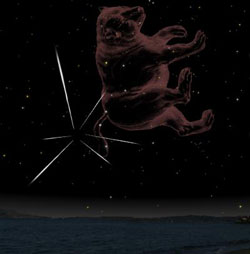Did Earth encounter pieces of an alien visitor last night?

Periodic meteor showers have been called the bones of comets. The Quadrantid meteor shower, visible in January, are the remains of an ancient comet observed by Chinese, Japanese and Korean astronomers 500 years ago. Credit: David A. Aguilar (CfA)<br>
NASA meteor experts had predicted it was a long shot, but the evenings of November 2nd and 3rd might display a meteor shower from dust which puffed off this visiting comet as it passed within twelve million miles of Earth.
And indeed, the Center for Astrophysics has collected several sightings of bright meteors called fireballs, which result when comet dust burns up in Earth's atmosphere.
Helga Cabral in Seascape, California reported after 9 pm last night, “I saw a bright white ball and tail, arcing towards the ocean. It was quite beautiful and it looked like it was headed out to sea and so picture perfect it could have been a movie!” Three thousand miles away just north of Boston, Teresa Witham witnessed a similar cosmic event.
“I was in the Revere area about 7:15 last night, driving north on Route 1, when a brilliant object with a tail passed in front of me – very similar in appearance to a shooting star but it appeared much lower to the Earth than a typical shooting star would be. If it weren't for the fact that I had my daughter with me, I'd begin to believe I'd imagined it.”
Comet Hartley 2 has put on quite a nice show for amateur astronomers over the past few weeks, sporting a vivid green coma or halo around it and a golden auburn tail of dust. NASA's Deep Impact/EPOXI probe will present dramatic close-up images of the comet when it zooms past the nucleus on November 4th.
When a comet approaches the Sun, it heats up unevenly, throwing off dust, ice and bits of rock. When the Earth encounters some of this space debris, it is seen as a beautiful meteor shower.
“Many people don't realize that the famous periodic meteor shower in August, the Perseids, is the remains of Comet Swift-Tuttle and the Orionids, appearing in late October, are leftovers from Comet Halley,” said Tim Spahr, Director of the Minor Planet Center at the Harvard-Smithsonian Center for Astrophysics in Cambridge, MA.
So for the next two evenings, we may see more of Comet Hartley 2. And if you have dark skies and a small telescope or binoculars, try to find Comet Hartley 2 itself. It will be near the bright star Procyon in the constellation Canis Minor near Orion the Hunter, which will be high overhead in the early hours before dawn.
Media Contact
More Information:
http://www.cfa.harvard.eduAll latest news from the category: Physics and Astronomy
This area deals with the fundamental laws and building blocks of nature and how they interact, the properties and the behavior of matter, and research into space and time and their structures.
innovations-report provides in-depth reports and articles on subjects such as astrophysics, laser technologies, nuclear, quantum, particle and solid-state physics, nanotechnologies, planetary research and findings (Mars, Venus) and developments related to the Hubble Telescope.
Newest articles

Trotting robots reveal emergence of animal gait transitions
A four-legged robot trained with machine learning by EPFL researchers has learned to avoid falls by spontaneously switching between walking, trotting, and pronking – a milestone for roboticists as well…

Innovation promises to prevent power pole-top fires
Engineers in Australia have found a new way to make power-pole insulators resistant to fire and electrical sparking, promising to prevent dangerous pole-top fires and reduce blackouts. Pole-top fires pose…

Possible alternative to antibiotics produced by bacteria
Antibacterial substance from staphylococci discovered with new mechanism of action against natural competitors. Many bacteria produce substances to gain an advantage over competitors in their highly competitive natural environment. Researchers…





















